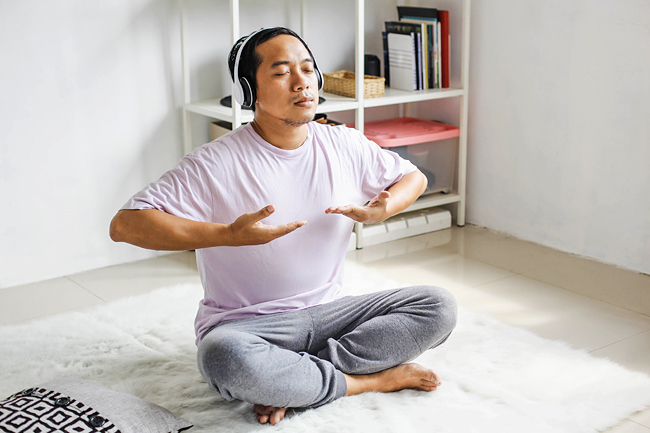Richard Sima
THE WASHINGTON POST – Most of us don’t think about our breathing, but if we put our minds to it, it can make us feel better.
“Respiration is the perfect interaction between conscious and unconscious,” said Psychiatrist and Neuroscience Professor Angelo Gemignani at the University of Pisa.
Breathing is a way for both the mind and body to work together to help regulate our emotions.
A study in Cell Reports Medicine showed that just five minutes of breathwork each day for about a month could improve mood and reduce anxiety – and these benefits may be larger than from mindfulness meditation for the same amount of time.
“We’re always busy doing instead of being,” said an author of the study David Spiegel. “And it’s a good idea to just take a few minutes to collect yourself, commune with your body and help it prepare to deal with whatever you want to deal with.”
In a randomised controlled study of 108 adults, the researchers compared three different breathwork exercises, in which participants deliberately guided their breathing in various ways, and mindfulness meditation, in which people observed their breathing but didn’t try to control it. The participants did the breathwork at home, following video instructions.



One group of participants was told to practice cyclic sighing.
Participants were instructed to slowly inhale through the nose to expand the lungs, and inhale again to maximally fill the lungs. Then they were asked to slowly and fully exhale the breath through the mouth.
A second group focussed on box breathing, which is spending the same amount of time slowly inhaling, holding the breath, exhaling and holding, before repeating the sequence.
A third group practiced cyclic hyperventilation, which “emphasises inhalation rather than exhalation. It’s kind of the mirror image of the cyclic sighing exercise”, said Professor of Psychiatry and Behavioral Sciences, and Director of the Center on Stress and Health at Stanford University Spiegel.
They took one deep inhalation through the nose, exhaled passively and then let the air “fall out from the mouth”, he said.
Every 30 cycles, they would hold the breath after passive exhalation for 15 seconds.
The fourth group performed mindfulness meditation, which emphasised being aware of breathing and their body – as opposed to actively controlling their breathing.
After 28 days, participants in both the mindfulness meditation and breathwork groups reported having more positive feelings and fewer negative ones compared with before they began their respective practices.
Participants in both groups also reported reduced feelings of anxiety.
“That’s not bad for five minutes a day,” Spiegel said. “It seems that practicing some control over your respiration is a kind of entry into one way of controlling your autonomic activity.”
The positive effects of breathwork took time to kick in: The more days the participants spent doing their breathing exercises, the better they felt each successive day.
Cyclic sighing appeared to be particularly effective among the different breathing exercises. Participants in this group reported even greater positive mood improvements compared with participants who practiced mindfulness meditation.
The key to mindfulness meditation, however, is to practice it as a daily life routine for an extended period of time, said Gemignani, who was not involved in the study and who provides longer breathwork and meditation interventions to his patients.
“I think five minutes are too short for inducing benefits for subjects.”
When we feel anxious, we tend to breathe faster. Breathwork exercises allow us to consciously slow down our breathing. And research shows it can not only affect mood but also physiology by inducing a more relaxed physical state.
One recent meta-analysis conducted by Gemignani and his colleagues suggests that slow breathing practices can affect our autonomic system, which regulates key physiological processes such as heart rate, blood pressure and breathing.
Specifically, these techniques seem to shift the balance away from the amped-up fight-or-flight sympathetic mode toward the more relaxed rest-and-digest parasympathetic system.
“One hypothesis is that just taking control of your breathing, and particularly in ways that would trigger self-soothing parasympathetic activity, is likely to improve mood and reduce your overall level of arousal,” Spiegel said.
In the new study, the cyclic sighers had a greater reduction in their respiration rate – how often they breathed – compared with the mindfulness meditators, although there were no differences in heart rate.
Interestingly, the more the respiration rate decreased in cyclic sighers, the more their positive emotions increased, suggesting that the participants who had the largest physiological changes may show the greatest benefit in mood. Breathwork may also enforce our sense of agency, Spiegel said.
“We like being in a situation where we can control not only what’s happening in the world, but what’s happening in our body, what we call interoception,” he said.
“So it feels good to know that you can do things that will help your body respond and feel more comfortable.”
Breathing in through the nose – which is employed in many breathwork practices – can also have a surprisingly large effect on the brain, Gemignani said.
Slow inhalation through the nose can trigger neural oscillations in the olfactory system, which may synchronise and slow down activity in wide swaths of the cortex and other brain regions such as the hippocampus and amygdala.
This slowing down of activity may be important for the positive mood effects of breathwork.
Spiegel said he plans to conduct follow-up neuroimaging research on how breathing practices may change the brain in the long term.
Breathing exercises are easier and more accessible than many meditative practices. Here are some tips to help you get started:
FIGURE OUT WHICH PRACTICES WORK BEST FOR YOU
This study’s results suggest cyclic sighing is superior, but the best breathing technique may depend on the individual.
Try out the three types of breathing techniques and see what feels right for you, Gemignani said. “The choice is only in the mind, the body, the brain of the single subjects,” he said.
START SMALL AND BUILD A ROUTINE
Try just five minutes and see how you feel when doing your preferred breathing exercise, Spiegel said. “It’s not so hard to make it part of your daily routine if it’s only five minutes of your time.”
You can also perform the breathing exercises for longer than five minutes, which may enhance the benefits.
USE IT WHERE AND WHEN YOU NEED IT
The beauty of breathing exercises is that you can employ them wherever you can breathe and whenever you need to de-stress and self-soothe.
Gemignani said he performs box breathing when walking down the street or even while swimming.
“I think what the study shows is that a small, safe, easy-to-use intervention can have big effects,” Spiegel said.
So when you are feeling anxious or down, remember to take a breath.







